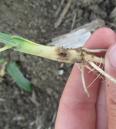A new iPad/Android tablet app offers a comprehensive approach to corn and soybean crop scouting, management and recordkeeping. So says Michael Koenig, who co-founded ScoutPro with Stuart McCulloh and Holden Nyhus through Iowa State University’s (ISU) Agricultural Entrepreneurship Initiative. Tap into university Extension photo references like ISU’s Weed Identification Field Guide to identify weeds, insects and diseases in the field. A click to save each pest identification uploads the information to create a report and puts GPS coordinates on the map, making it easier to locate and manage the problem.
ScoutPro will add files to create field-specific reports without the need to re-enter information.
“If you’re not sure of the pest ID, you can take a picture with the app and send it to a consultant for confirmation,” says Koenig. “Back in the office, you can pull up the full scouting report to add details, or you can e-mail reports from the field.”
Originally designed so that commercial scouting services could aggregate data from multiple scouting sites, ScoutPro also offers a farmer version.
“It’s easier than sifting through a bunch of pocket manuals,” Koenig says.
At Co-Alliance, Ag Technology Manager Luke Lightfoot says the company’s scouts liked ScoutPro in trials during 2012. “It was very user-friendly, especially for the app worked well for veteran and new scouts. Our advanced scouts also liked it because of the data entry,” Lightfoot says.
“We have 26 agronomy facilities in Indiana, Ohio, and Michigan, so we wanted a standardized program that allowed us to manage our scouting teams and the collected data from one location.”
In December, Co-Alliance adopted ScoutPro company-wide.
“We’re seeing more demand for scouting because of the increase in crop values,” says Lightfoot. “Farmers liked the quick response with ScoutPro because a lot of what the scouts find needs to be addressed quickly.
“The biggest advantage with this app is the farmer can log onto the email system and see what’s going on in his fields now, versus looking at the combine’s yield map, scratching his head, and wondering why he’s got a 20-bu. loss in a field.”
ScoutPro is continuing to expand the app’s uses. It now includes information for Iowa, Illinois, Minnesota, Indiana, Ohio, North Dakota, South Dakota and Wisconsin. Nebraska is being added.
“As we expand and get the corn and soybeans sections right, we’re moving on to other crops. We’re looking at wheat and small grains,” Koenig reports. “We’re looking at collecting multiple years of data so you can see how fields are trending. That’s going to be especially important in corn-on-corn production.”
This year, the company plans to add chemical reference data from Greenbook Data Solutions and is considering adding irrigation reference information.

